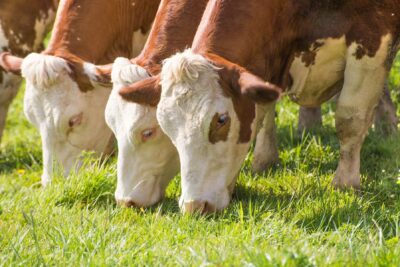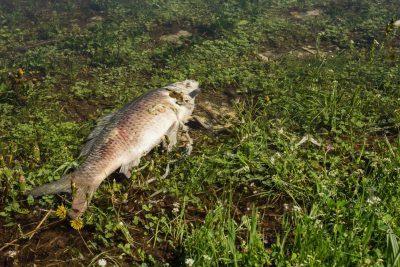“Grass-fed” sounds an awful lot like a return to nature. Or at least a return to the “old days.” But it’s more than that. Marketers dream of a grass-fed future, cows of a grass-fed death, and a couple years ago, Forbes even published an article declaring that we already, “Live In A Grass Fed Era”.
The idea has a lot going for it. It’s a dream of sunny green pastures , winding dirt roads, and swallows nesting on the roof of a barn whose red paint will never chip. It’s an idyllic vision of healthy cows, happy cows, chewing yellow dandelions behind a white picket fence. It’s a picture-perfect paradise, both for the animals and the planet.
Images like these are also airbrushed with euphemistic language that encourage everyone, from farmer to consumer, to feel great about themselves: farm fresh, hormone-free, ethically treated, antibiotic-free, non-GMO, all natural, organic, small farm, etc. These words, and the emotions attached to them, implicitly suggest environmental sustainability. But is grass-fed meat really more environmentally sustainable? If Forbes is correct and we’re truly living in a “Grass Fed Era,” does that mean that we’re pumping the brakes on climate change, deforestation, soil erosion, droughts, and other indices of environmental collapse?
Assuming no change in the total number of cattle and swine currently consumed in the United States, we would need more than 2.5 billion acres of land for that to happen.
Let’s do the math. On the smallest scale, one cow requires a minimum of two acres of pasture land and 20–30 gallons of water daily. That is, assuming the two acres are fully covered with good grazing land (in some places, cows require more acreage because the pasture isn’t filled out with healthy grass for grazing). Additionally, in the winter months, grain will often have to be purchased. But for the sake of argument, let’s assume optimal efficiency, or two acres per cow.
Now, assuming no change in the total number of cattle and swine currently consumed in the United States, we would need more than 2.5 billion acres of land. The problem, as it happens, is that there are fewer than 2.3 billion acres in the entire United States, including all the mountains, swamps, deserts, and otherwise unsuitable land areas you can imagine. Alaska alone accounts for 17 percent of the United States’ total acreage. And remember, that 2.5 billion required acreage is only for cattle and swine. Would you like to include the 250 million grass-raised turkeys, seven million sheep, and eight billion chickens currently consumed each year? 1
Can something be sustainable when it isn’t even feasible?
On the farm neighboring me, here in the Dominican Republic, there are 82 head of cattle on 200 acres. The farmer has told me that these 200 acres have reached maximum capacity. That’s about 2.44 acres per cow. It takes two years for a grass-fed cow to reach full maturity, at which point it can be slaughtered for about 450 pounds of flesh. That means my neighbor can expect to produce approximately 36,900 pounds of meat, every two years (82 x 450 = 36,900).
Meanwhile, here at the Global Roots center, we’ve chosen to grow a variety of plants. We have about two acres total. Between tiered agroforestry and garden beds, we’re growing a wide variety of fruits, root crops, legumes, and vegetables: avocados, zapotes, plantains, bananas, rulos, oranges, grapefruits, lemons, cashews, mangoes, cherries, guayabas, star fruit, papayas, cacao, sweet potatoes, cassave, yautia, llame, black beans, pigeon peas, peanuts, eggplants, tomatoes, cucumbers, okra, peppers, onions, lettuce, Swiss chard, kale, granadilla, pineapple, passion fruit, chayote, coffee, garlic, and sugar cane. Coronel, the chief gardener at the Global Roots center, has been growing, harvesting, and selling food in this area for decades. He projects that we will have at least 100,000 pounds of organic produce, from our two acres of land, after two years. Having looked at the estimated yields for various crops, I think this is actually a relatively conservative estimate.
On two acres of land, over a two-year period, one can produce 450 pounds of animal flesh or 100,000 pounds of plant produce, using almost no water, compared to the 20–30 gallons required for each cow, every day.
The Grass-Fed Era may not be long-lived, but neither will our future, if we cannot reassess the true meaning of sustainability and adopt a more plant-based way of eating.
LeAnne Campbell has a PhD in Education and over 30 years of experience designing and directing education initiatives, specifically leadership programs, professional development workshops, conferences and curriculum development workshops. She currently lives in the mountains of La Cumbre, Dominican Republic and is the president and founder of Global Roots which is located within the SOMOS Education Center.
Learn more about LeAnne Campbell and the science of nutrition at NutritionStudies.org
1 Oppenlander, R. 2012. Comfortably Unaware. Beaufort Books



